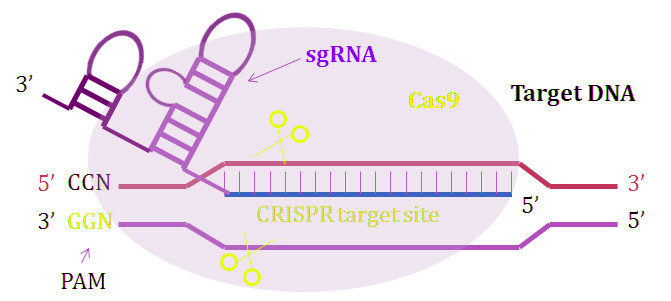 |
| Previous Image | Next Image |
| Description: CRISPRs have recently been utilized as genome editing tools in a wide range of species. The engineered CRISPR-Cas9 system allows researchers to mutate or change the expression of genes in living cells, including those of humans. The CRISPR-Cas9 genome-editing system is one of the most convenient methods available for making alterations in the genome, demonstrating that a specific gene is playing a role in the development of the disease. The system can not only be used to test the effects of mutations in vitro, but also can be harnessed to study gene functions using intact biological systems. The function of CRISPR-Cas9 system relies on two key features : a enzyme called Cas9 and guide RNA. The Cas9 enzyme can present some delivery challenges for in vivo applications. The family of Cas9 nucleases recognizes DNA targets in complex with RNA guides. Researchers can take use of this system to home in on specific nucleic acid sequences and cut the DNA at those precise targets. The cuts modify the activity of the targeted genes, allowing researchers to study the genes\' function. The CRISPR-Cas9 mouse model has been created by researchers with the purpose to simplify application of the CRISPR-Cas9 system for in vivo genome editing experiments. These researchers successfully used the new “Cas9 mouse” model to edit multiple genes in a variety of cell types, and to model lung adenocarcinoma, one of the most lethal human cancers. To date, the mouse has already been made available to the scientific community and is being used by researchers at many institutions around the world. By equipping the mouse with Cas9, the burden of delivery is relieved, which frees up space for the delivery of additional elements, making it possible to simultaneously mutate multiple genes and make precise changes in DNA sequences. Its ability to perturb multiple genes at the same time may be particularly useful in studying complex diseases, such as cancer. Research that uses “Cas9 mouse” to model lung adenocarcinoma has demonstrated the system’s potential application for cancer research. In the past, the research processes working with animal models were challenging and time consuming. However, the Cas9 mouse allows researchers to more easily perturb multiple genes in vivo, as they can more rapidly screen through the long list of genes that have been implicated in disease and normal biological processes. Besides, it has been discovered that cells derived from the Cas9 mouse can be extracted for use in lab experiments and are able to leverage the Cas9-expressing cells to edit immune dendritic cells after removed from the mouse, allowing researchers to experiment with cells that aren’t easily accessible and often lack the shelf life to conduct such experiments. About us Creative Animodel, as a world leader in custom transgenic animal model, offers high quality CRISPR/Cas9 System for mutagenesis and genome editing. Creative Animodel has years of experience serving hundreds of clients across six continents. Its full-service model has enabled medical and academic researchers to receive over 1,000 successful and unique gene targeted animal model lines. Picture Stats: Views: 2006 Filesize: 51.24kB Height: 301 Width: 671 Source: https://biology-forums.com/index.php?action=gallery;sa=view;id=20539 Keywords: CRISPR-Cas9 mouse model CRISPR-Cas9 system |
